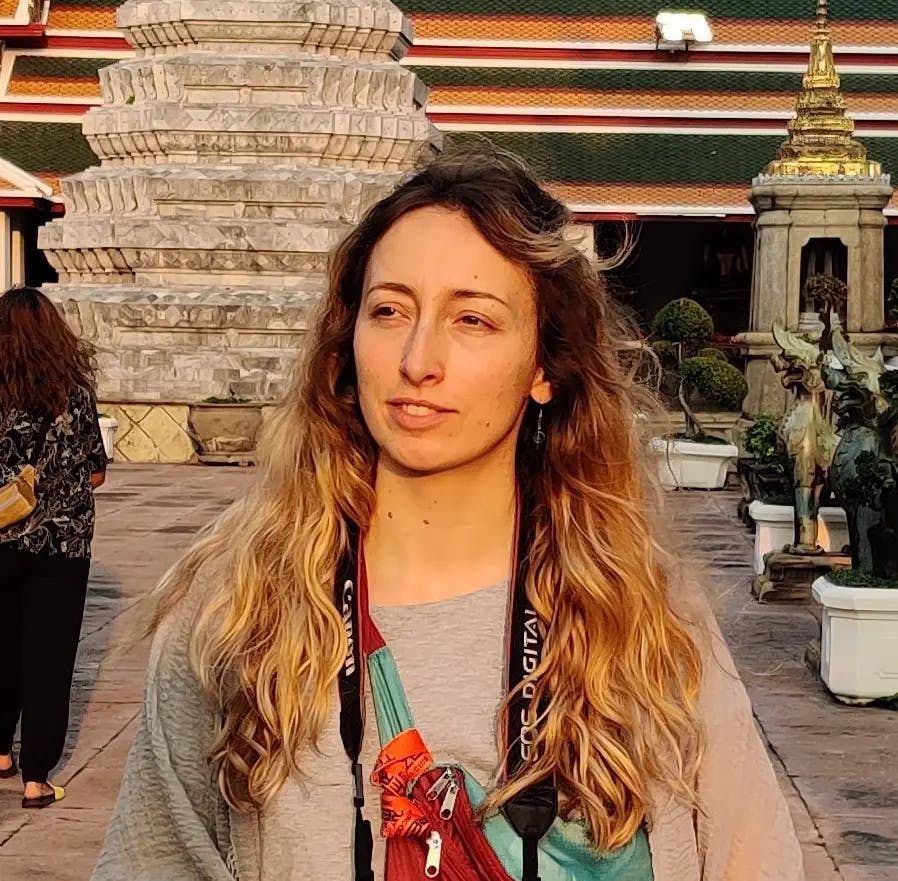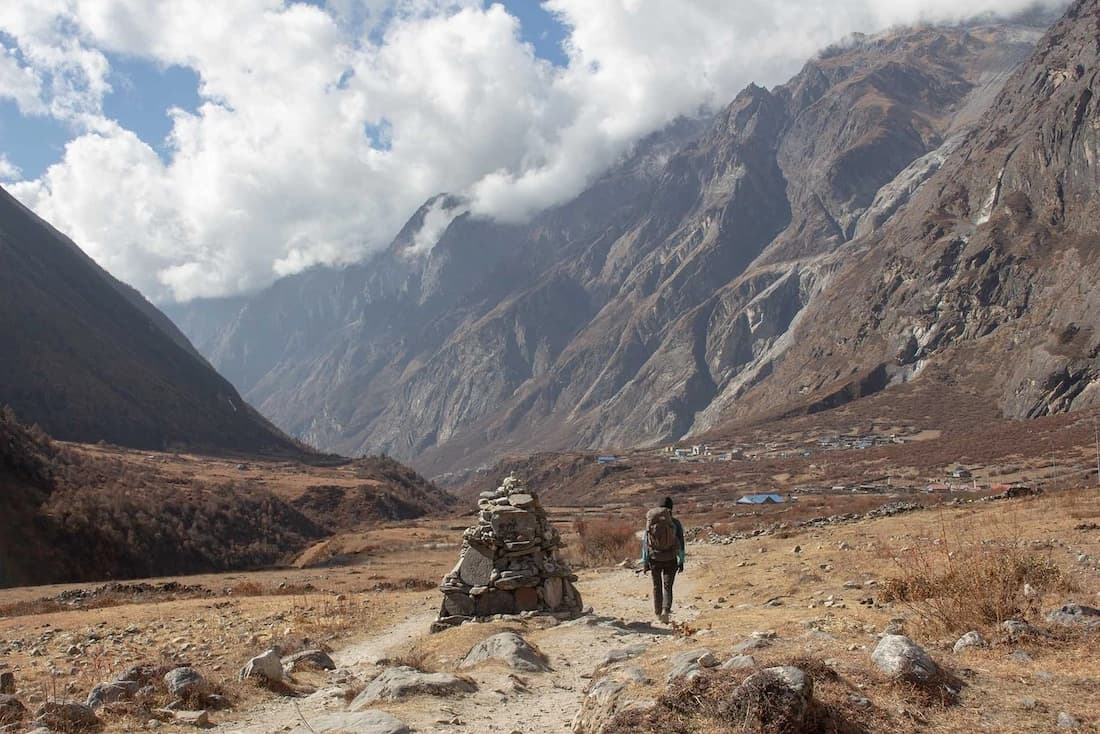I’ve written two articles about my Langtang Trek, but trekking rules in Nepal keep changing. Please search for official guidance and remember that even if you can trek without a guide you will still need to get your National Park Entrance Permit. This page will give you details which will help you plan your own trek, otherwise, here you will be able to read about my own experience in Langtang Valley without a guide.
Hiking in the Himalayas
As we know the Himalayas are the tallest mountains in the world, but when you’re near them, the size of them is hard to fathom - they stand as a testament to the extremes of our planet, where the environment can shift dramatically within just a few miles. You're surrounded by tropical forests and rice paddies, the air heavy with warmth. And then, just by lifting your eyes, you're confronted with the cold and silent giants above.
The people who live in the shadow of these mountains, like the Tamang and Sherpas, have a unique relationship with the land. Historically, the Himalayas have been a formidable barrier, shaping the geopolitics and trade routes of the region - they have served as a natural fortress, protecting and isolating communities, thus preserving unique cultures and ways of life. This isolation contributed to the development of distinct languages, customs, and religious practices, making each trek unique.
The different communities are a blend of tradition and adaptation, built on centuries of living in these extreme conditions. They navigate the challenges posed by the environment with a deep understanding and respect for it. Their cultures, languages, and lifestyles are inseparable from the Himalayas - this connection and balance is something valuable, which the rising tide of tourism, driven by personal achievement and the desire to tick off 'bucket list' experiences threatens.
This surge in visitors, while beneficial for the economy, risks overlooking the fragile ecosystems and the finely balanced lives of the local communities. The environmental footprint and cultural impact of over-tourism, especially in places like Everest, highlight the urgent need for responsible trekking practices.
Fun Fact: Nepal’s neighbour, Bhutan, has taken a completely different approach to tourism, by making visitors pay a hefty sum per day, making it the country with the highest tourist tax in the world ($100 a night). Could this be a solution to saturated tourist hot-spots?
The Langtang Valley Trek
The Langtang Valley trek starts from Syabru Besi - this is not just the beginning of the Langtang Valley trek but also serves as a gateway to other treks in the area. Among these is the Tamang Heritage Trail, which is renowned for being rich of cultural insights, stunning landscapes including views of the Ganesh Himal.
People start the trek the day after their bus journey and usually head towards Kyanjing Gompa, this spans over 2 to 3 days, but may vary based on your walking pace and how early in the day you set off. The path starts in valley's narrower sections, adorned with patches of trees and shaded conditions during November mornings.
What is usually the third leg from Langtang village to Kyanjing Gompa is known for being relatively flat and short, allowing swift trekkers to include it in their second day/leg.
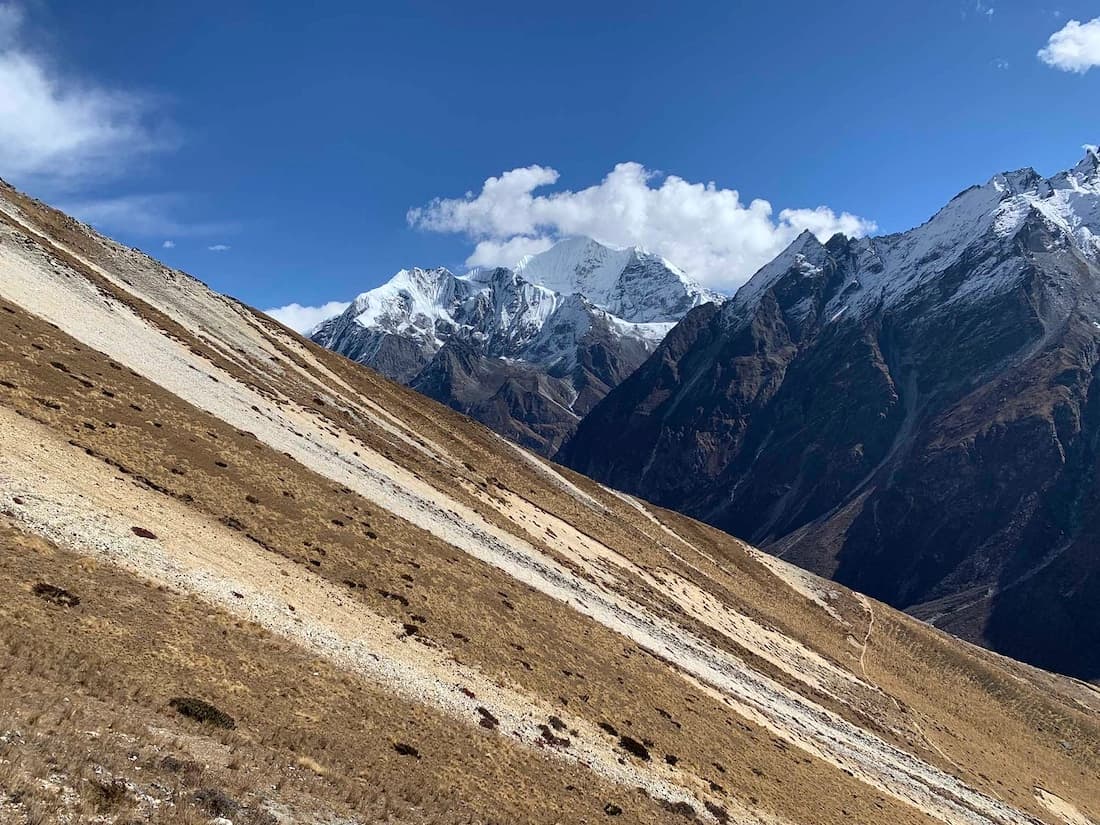
Landslides in the upper part of Langtang Valley
Why chose Langtang Valley?
I hope you’re already intrigued, but I will explain further why Langtang was our choice for our trekking adventure. We were influenced heavily by conversations with other travellers and our own experiences in crowded hiking destinations. One of my previous treks in 2023 was to Mount Rinjani in Lombok, Indonesia, where the amazing views were overshadowed by the sheer number of people on the trail, leading us to seek out a less trodden path for our Himalayan journey.
Langtang Valley stood out not just for its breathtaking scenery, which aligned perfectly with our imagination of the Himalayan landscape, but also for its relative remoteness. Wherever you hike in the Himalayas you will feel that remoteness, but it’s rare to find fully-blown villages so far from main roads. The thought of a place so secluded that supplies have to be ordered two days in advance sparked our curiosity.
The trek's well-defined path was another good reason for choosing Langtang. For various reasons, we wanted to go without a guide, but walking in the Himalayas without a guide carries its risks. Langtang's straightforward route offered a comforting sense of security, allowing us to explore on our own terms without the anxiety of getting lost. It’s very easy to stick to the path.
Once you get to Nepal and start chatting to people you will realise how many treks there are other than EBC (Everest Base Camp), ABC (Annapurna Base Camp) and the Annapurna Circuit which seem scarily over popular - but that’s just my perspective :)
Hiking Permits for Langtang
Everyone has to obtain a Langtang National Park Entry Permit. The permit costs 3,000 NPR (about 22 USD) for non-nepalese or 1500 for SAARC Nationals. We go ours at the Nepal Tourism Board office in Kathmandu—open during regular business hours, usually from Sunday to Friday. Alternatively, if you’re heading straight to the trail, I we saw people getting theirs at the park entry checkpoint in Dhunche.
If you want to do it at the tourism board, go along with your passport and a passport-sized photo (photos are sometimes taken on the spot), it’s usually a relatively quick process, so getting the permit in Kathmandu in advance can avoid delays and subsequently the bus leaving you at the checkpoint!
Langtang trekking permit
Where is Langtang and how to get there?
Langtang Valley nestles within the Rasuwa District of Bagmati Province, positioned to the north of Kathmandu. Every day, from 7:30 am onwards, direct buses set off from the north-west corner of Kathmandu’s ringroad. The journey to Syabru Besi, the starting point of the Langtang Valley trek and takes approximately 9 hours by bus.
There will be a lunch break, where as well as getting a brilliant slap-up meal, you might be lucky and get some fresh fruit for the first few days of the trek - because of the remoteness, it’s hard to find other fruit except apples in higher altitudes.
We were warned about the bus route and calling it as the scariest bus ride of my life wouldn't be an exaggeration. The challenge of this road, however, is well-compensated by the breathtaking views.
For those with a fear of heights, the road to Syabru Besi will be an issue. It's a lengthy and winding two-way dirt track, with almost vertical drops, especially on the left side as you approach Syabru Besi. This path not only tests your nerve but also your endurance - people say you should be able to spot a bus which didn’t make it, if you can confirm this, please write to us as we did not see it and have been wondering ever since.
It's important to note that you will need the Langtang National Park Entry Permit which costs about $30. The TIMS card is not required for Langtang Valley. It can be obtained in Kathmandu or at the first checkpoint on the way to Syabrubesi.
Local bus is what I recommend, but some people also hire jeeps on a sharing basis.
History of Langtang Valley
The Tamang, with roots tracing back to Tibet, have long been the valley's primary inhabitants, contributing significantly to their unique customs, language, and Buddhist practices.
Agriculture and livestock herding have formed the backbone of the local economy in Langtang. However, since the mid-1970s, tourism has emerged as a vital source of livelihood, with trekkers drawn to the valley's trails and the opportunity to experience its vibrant local practises. The introduction of Swiss cheese-making in the 1950s by Werner Schulthess (https://nepalitimes.com/banner/the-story-of-langtang-cheese) added a unique aspect to the region's economy, making nak (female yak) cheese a celebrated product of Langtang.
The area was tragically impacted by the devastating earthquake in April 2015, which resulted in the near-total destruction of Langtang village due to a massive avalanche triggered by the quake. The disaster claimed the lives of hundreds, including many residents, visitors and livestock. The aftermath saw the community's incredible efforts to rebuild, highlighting their resilience. The reconstruction of key facilities, such as the cheese factory and the centuries-old gompa at Kyanjin Gompa, showcases the community's commitment to preserving their heritage and welcoming tourists back to their rebuilt homes.
The original dry-stone houses are mostly gone, but you can still see a few in Mundo village. In this area of the hike you will also start to see the Prayer walls decorated with Mani Stones each with a different mantra. Like when you’re visiting the stupas you are supposed to always go round clockwise, so here you would be staying on the left of the walls.
Langtang landslide from the earthquake in 2015
Tea Houses, food and sleeping arrangements
Throughout the Langtang Valley, you'll find teahouses and lodges in the small villages all along the walk. These accommodations offer warm kitchens and cozy dining areas heated by stoves with huge teapots on top.
The arrangements for sleeping in these teahouses are mostly comfortable, with many offering duvets and comfy mattresses, contrary to some online accounts of damp and unclean bedding. Expect clean beds, blankets, and generally shared bathrooms with the option of hot water sometimes for a little extra. It's advisable to bring your sleeping bag for additional warmth, especially at higher elevations.
The teahouses along the Langtang Valley trek provide dishes like Dal Bhat, noodles, soups and some western dishes. While the food offerings become simpler as you ascend due to the remoteness and difficulty in getting supplies, the quality of the food remains high. You will also notice the prices of the food on treks in Nepal be about 5/6 times the price you would pay in Kathmandu.
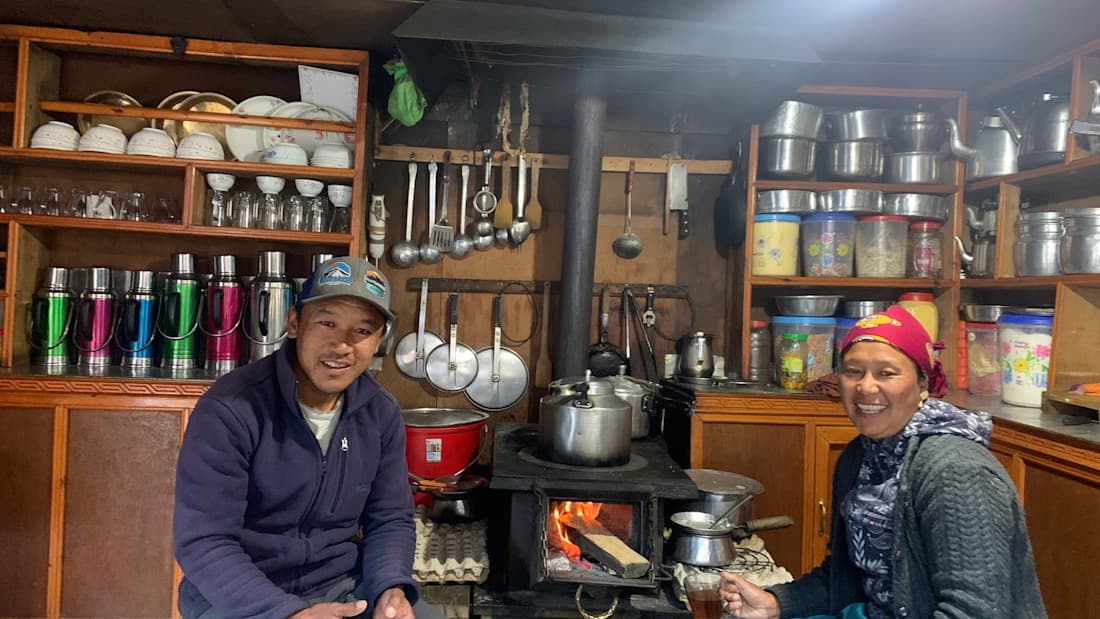
Teahouse in Langtang village
Difficulty, terrain and weather
The Langtang trek is suitable for regular trekkers and fit beginners. Packing the right gear (not too much) and acclimatising properly to avoid altitude sickness are the main things to worry about.
The trek up to Kyanjin Gompa in the Langtang Valley is often described as moderately challenging, particularly due to the altitude rather than the terrain itself. The initial two days of the trek involve the steepest ascents, and as you gain altitude, the need to take breaks becomes more frequent due to the thinner air. While most of the path is stable, there are certain sections with loose stones.
Comparatively, the Langtang Trek is considered to be more forgiving in terms of acclimatisation compared to other popular treks, as the gradual ascent and the proximity of villages with accommodation allow trekkers to pace themselves according to their needs.
The best times of year to do the Langtang Valley trek are during spring (March to May) and autumn (September to November). These periods offer stable weather and clear skies. It's advisable to avoid the monsoon season due to heavy rainfall, which can make the trails and roads muddy and slippery, and the winter season, which can introduce colder temperatures and snowfall.
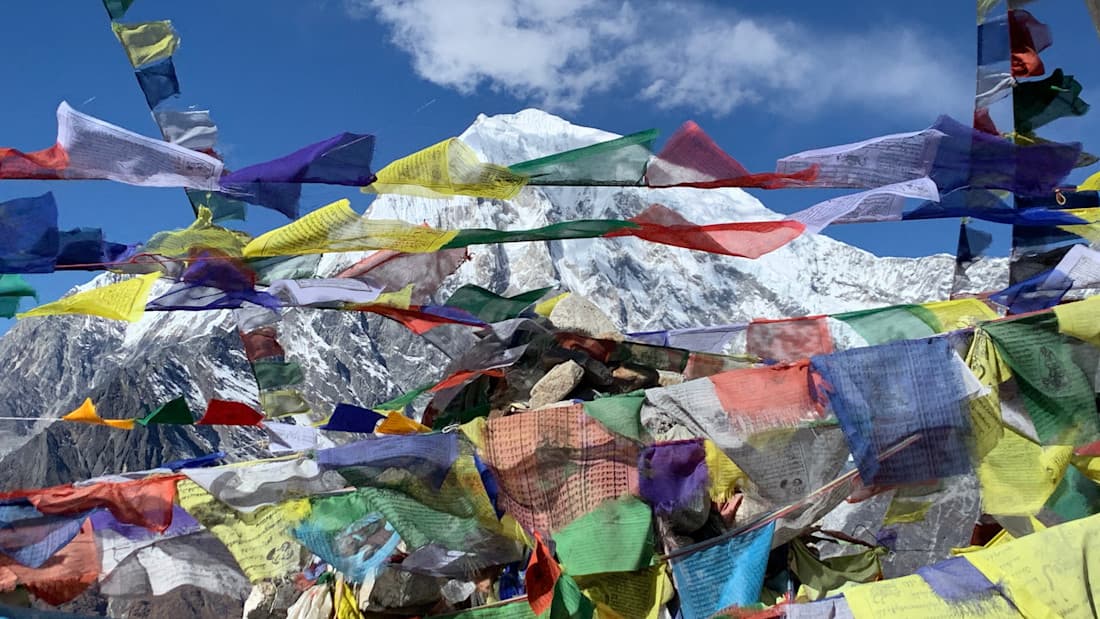
Prayer flags on Kyanjin Ri
Things to look out for
On your trek through Langtang Valley, you'll see lots of amazing sights, including huge hanging bee hives at the beginning of the trail, hot sea buckthorn juice from high-altitude plants, and cheeky langurs probably being chased by someone with a slingshot. These primates are larger and more visually striking than Kathmandu's macaques - quite elegant.
The journey also introduces you to the local nak cheese factory at Kyanjin Gompa, where you can buy cheese as well as see the process. There are a few bakeries along the route offer pastries like apple cake and carrot cake - I know, not quite what you would expect up here. Watch out for the mule caravans and always stay on the inside of the path when they march past you.
The presence of yaks and naks are one of Langtang’s famous characteristics - they can be frisky at times, but are usually quite relaxed and won’t bother you.
Food to try while in Langtang
In addition to dishes like Dhal Bhat, Sherpa Stew and Tsampa Porridge, Langtang offers a variety of foods, including traditional both Tibetan and Nepalese dishes such as Tingmo buns, Thakali Khana and Momos which you’ve certainly seen before Langtang. You'll also spot Western food options, such as pasta and pizza. Things like Sel Roti may be more available in villages on your way up or down to Syabru Besi, rather than directly on the trek itself.
Dhal Bat
Kyanjin Ri or Tsergo Ri
These two summits are what most people choose to do. Some pick between the two, others tackle both, and there are quite a few who decide to stay longer in Kyanjin to try the valley walks, which are also stunning, or, if more experienced, head to Yala Peak.
Kyanjin Ri stands at 4,773 metres and offers a shorter hike with panoramic views of the frozen lake and the east side of Langtang Lirung and its base camp.
The hike to Tsergo Ri, at 4,998 metres, presents more of a challenge as it involves a 1,200-metre climb to be done in 4 hours, making it quite steep. Once at the top, you're treated to a 360-degree view of peaks in Tibet and other towering 6000m peaks, alongside a splendid view of Langtang Lirung’s east side.
For clear views, starting the hike early, around 6:30/7am, is recommended. There are two options for the return hike to Kyanjin Gompa: the first, the way you came, and the second, a longer loop around, which crosses paths with numerous landslides, which made me a bit giddy, but the colours of the scenery were definitely worth it.
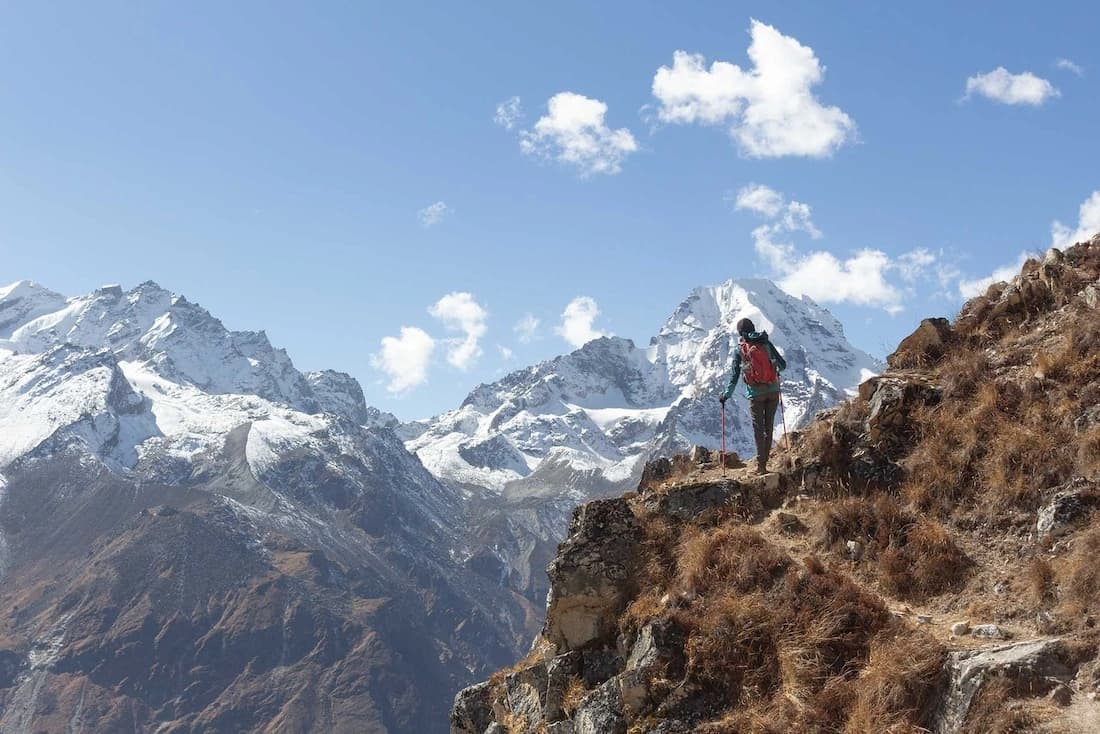
Hiking back to Kyanjin Gumpa from Tsergo Ri's summit
Other hikes in the area
I didn’t realise before starting our journey that there are other remarkable trails in the area which we might have tried to do if we had been able to spend longer.
The Langtang Heritage Trail offers insights into the unique cultures and traditions of the local communities, helping one understand the region's heritage.
The Gosainkunda Lakes trek is a spiritual journey to a series of high-altitude, sacred lakes, renowned for their serene beauty.
Further up the valley from Kyanjin Gompa, trekkers can venture into less-traveled paths, discovering pristine landscapes and remote hermitages.
What to pack?
For trekking in Langtang, pack layers but avoid overpacking to manage your temperature. Essentials include a thermal top, fleece, leggings for day hikes, and warm clothing like ski trousers and jacket, thick socks, gloves, and a snug hat for chilly evenings. Consider renting additional trekking gear in Thamel, Kathmandu, if needed.
Langtang trek cost
The cost of the Langtang trek varies, especially with the new 2023 regulations on guided treks. Opting to go without a guide, you might spend around £250 on accommodations and meals, necessitating cash for all transactions, as ATM access will be impossible. I would suggest taking around 45000 Nepalese Rupees, for your expenses - this should last you 7/10 days. Some people negotiate lodging costs in exchange for meals - please don’t do this as it’s disrespectful towards the people hosting you.
Nepal guide laws and Langtang Trekking Pass
To trek in Langtang, a Trekking Pass is needed, available at Kathmandu's Tourism office or the park's entrance. As of April 2023, new laws mandate all solo or foreign trekkers in protected areas to hire a local guide, supporting safety and job creation. Despite debate over freedom and cost implications, guides offer cultural insights and logistical support, enhancing the trekking experience. Although at the park’s entrances there are permit checks and luggage inspections for drones there are still no checks to insure you have a guide.
Where we stayed:
- Ganesh View hotel
- Resting Place Guest House
- Langtang View Guest House
- Sunrise Guest House
View from bedroom at Sunrise Guest House
How to make it more responsible and sustainable
To try and be as sustainable as possible in Langtang, avoid asking for free accommodation in exchange for meals, as rooms are priced at just 500/1000 Nepalese Rupees.
Use water tablets and a reusable bottle to reduce plastic use.
Instead of buying gear try renting gear it, this way you can support local businesses and decrease environmental impact.
If I were to do it again?
Next time, I'd start from the town before Syabru Besi, Thulo Bharkhu for a prettier initial route.
Pre-booking lodges wouldn't be on my list; rather, I'd shortlist ones that catch my eye, but go with who I meet along the way.
I would also give myself a bit more time to see more of the area. Exploring the Tamang Heritage Trail for its cultural insights would be a priority as I’ve heard so many good things about it.
Things to Not Forget:
Pack essentials like a powerful power bank, a thermos for warm beverages during breaks, a head torch for early mornings or late evenings, enough cash (around 45000 rupees should suffice for a week), water purification tablets, and energy-boosting snacks like ginger and nuts.
Interesting Facts:
Be prepared for rising food costs as you ascend, additional charges for wifi and hot showers, and the absence of mobile signal shortly into the trek.
Remember, when encountering mule caravans, it's safer to stand on the mountain side.
Although some trekkers trade meals for free lodging, contributing financially supports the local economy better.
Lastly, it's intriguing to see Yak poo is used as a fuel source for the stoves!
